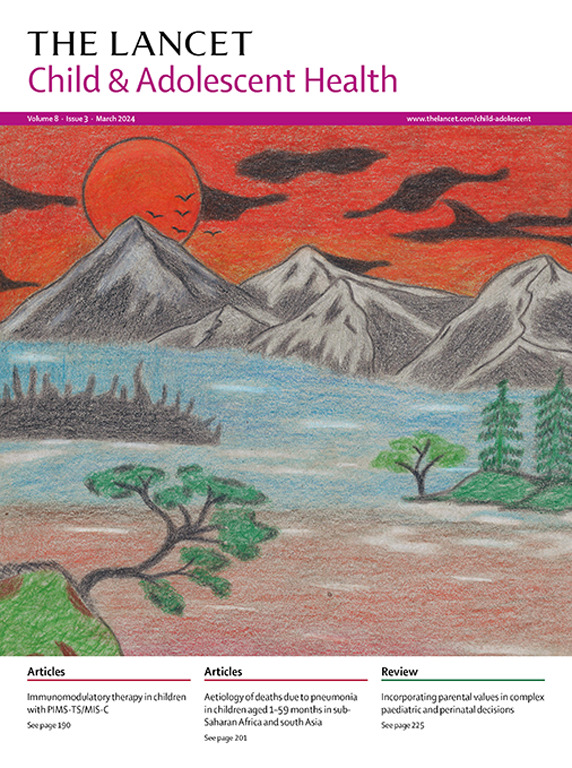尼西维单抗对婴儿呼吸道合胞病毒疾病的实际疗效:系统评价和荟萃分析
IF 15.5
1区 医学
Q1 PEDIATRICS
引用次数: 0
摘要
nirsevimab于2023年获批,并在几个高收入国家的全婴儿免疫规划中实施,以预防由呼吸道合胞病毒(RSV)引起的下呼吸道感染(LRTI)。了解广泛的尼瑟维单抗规划的实际有效性对于验证临床试验中观察到的益处和指导免疫政策至关重要。我们评估了nirseimab在引入婴儿免疫规划的人群中的实际有效性。方法:本系统综述和荟萃分析,检索了MEDLINE、Embase、Web of Science、Scopus、Global Health和medRxiv,检索时间为2023年1月1日至2025年2月25日,以确定在常规临床实践中针对2岁或2岁以下婴儿免疫规划的观察性研究,报告了nirsevimab实际有效性的原始数据。主要分析集中在12个月或更小的婴儿身上。采用反方差随机效应模型对与rsv相关的住院率、重症监护病房(ICU)住院率和与rsv相关的LRTI发生率进行汇总分析。对于住院时间,我们使用限制最大似然随机效应模型来估计尼西维单抗组和对照组之间的加权平均差(WMD)。本研究已在普洛斯彼罗注册(CRD42024628782)。研究结果:我们鉴定并筛选了1238项记录,其中来自5个国家(法国、意大利、卢森堡、西班牙和美国)的32项队列和病例对照研究被纳入系统评价,其中27项被纳入荟萃分析。Nirsevimab与rsv相关住院的较低几率相关(优势比0.17;95% ci 0.12 - 0.23;I2= 85.8%),进入ICU的几率较低(0.19;0·只剩12·29;55.6%),下呼吸道感染发生率较低(0.25%;0·19-0·33;0-12个月的婴儿患病率为35.1%。然而,尼塞维单抗组和对照组的住院时间没有差异(WMD为0.01;95% CI - 0.63 ~ 0.65;I2 = 62·3%)。我们的研究结果表明,在临床试验中观察到的nirseimab的益处在现实环境中也很明显,有效地减少了婴儿RSV疾病的负担,从而减少了医疗保健使用。加拿大自然科学与工程研究委员会和加拿大免疫研究网络。本文章由计算机程序翻译,如有差异,请以英文原文为准。
Real-world effectiveness of nirsevimab against respiratory syncytial virus disease in infants: a systematic review and meta-analysis
Background
Nirsevimab was approved in 2023, and implemented in all-infant immunisation programmes in several high-income countries to prevent lower respiratory tract infection (LRTI) caused by respiratory syncytial virus (RSV). Knowledge of real-world effectiveness of broad nirsevimab programmes is crucial to validate the benefits observed in clinical trials and guide immunisation policy. We assessed the real-world effectiveness of nirsevimab in populations where infant immunisation programmes were introduced.
Methods
For this systematic review and meta-analysis, we searched MEDLINE, Embase, Web of Science, Scopus, Global Health, and medRxiv from Jan 1, 2023, to Feb 25, 2025, to identify observational studies of immunisation programmes for infants aged 2 years or younger in routine clinical practice reporting original data for the real-world effectiveness of nirsevimab. The primary analysis focused on infants aged 12 months or younger. Pooled analyses were done with inverse-variance random-effects models for RSV-related hospital admissions, intensive care unit (ICU) admissions, and RSV-related LRTI incidence. For length of hospital stay, we used a restricted maximum likelihood random-effects model to estimate the weighted mean difference (WMD) in days between the nirsevimab and control groups. This study is registered with PROSPERO (CRD42024628782).
Findings
We identified and screened 1238 records, of which 32 cohort and case-control studies from five countries (France, Italy, Luxembourg, Spain, and the USA) were included in the systematic review and 27 of them were included in the meta-analysis. Nirsevimab was associated with a lower odds of RSV-related hospitalisation (odds ratio 0·17; 95% CI 0·12–0·23; I2=85·8%), a lower odds of ICU admission (0·19; 0·12–0·29; 55·6%), and a lower odds of LRTI incidence (0·25; 0·19–0·33; 35·1%) in infants aged 0–12 months. However, length of hospital stay did not differ between the nirsevimab and control groups (WMD 0·01; 95% CI –0·63 to 0·65; I2=62·3%).
Interpretation
Our findings indicate that the benefits of nirsevimab observed in clinical trials are also evident in real-world settings, effectively reducing the burden of RSV disease in infants and, consequently, health-care use.
Funding
Natural Sciences and Engineering Research Council of Canada and the Canadian Immunization Research Network.
求助全文
通过发布文献求助,成功后即可免费获取论文全文。
去求助
来源期刊

Lancet Child & Adolescent Health
Psychology-Developmental and Educational Psychology
CiteScore
40.90
自引率
0.80%
发文量
381
期刊介绍:
The Lancet Child & Adolescent Health, an independent journal with a global perspective and strong clinical focus, presents influential original research, authoritative reviews, and insightful opinion pieces to promote the health of children from fetal development through young adulthood.
This journal invite submissions that will directly impact clinical practice or child health across the disciplines of general paediatrics, adolescent medicine, or child development, and across all paediatric subspecialties including (but not limited to) allergy and immunology, cardiology, critical care, endocrinology, fetal and neonatal medicine, gastroenterology, haematology, hepatology and nutrition, infectious diseases, neurology, oncology, psychiatry, respiratory medicine, and surgery.
Content includes articles, reviews, viewpoints, clinical pictures, comments, and correspondence, along with series and commissions aimed at driving positive change in clinical practice and health policy in child and adolescent health.
 求助内容:
求助内容: 应助结果提醒方式:
应助结果提醒方式:


